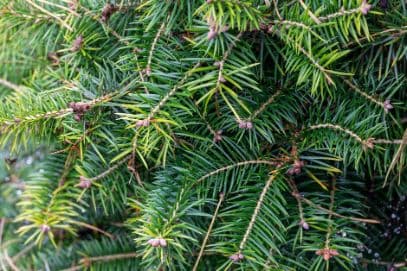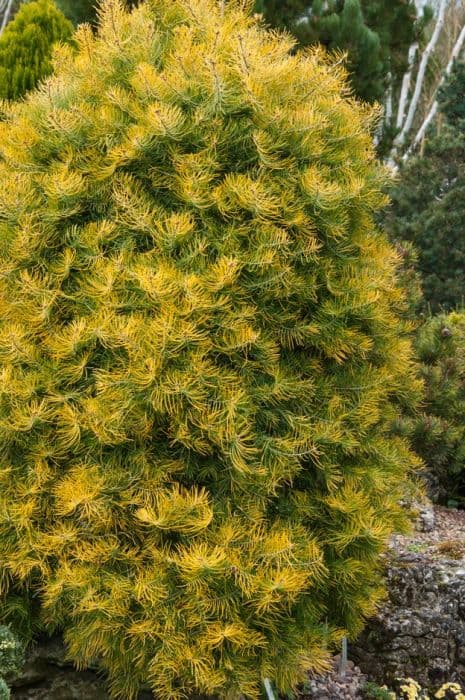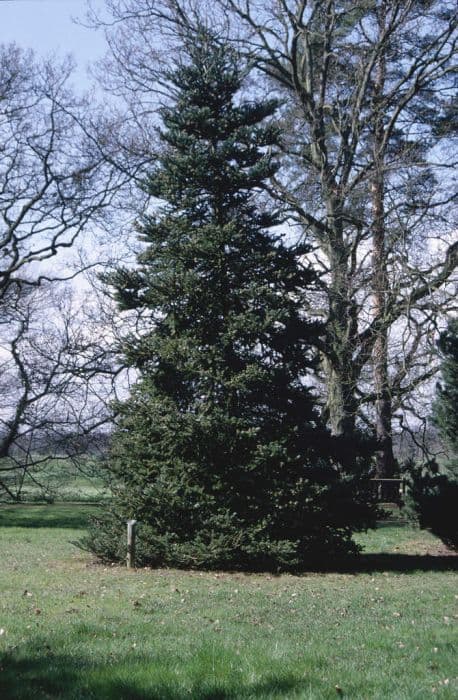Monterey Pine Pinus radiata (Aurea Group) 'Aurea'

ABOUT
The Pinus radiata 'Aurea', commonly known as the Monterey pine 'Aurea', is a striking plant characterized by its distinctive foliage that sets it apart in the landscape. The needles of the Monterey pine 'Aurea' are long and slender, presenting a soft, almost feathery appearance. They grow in bundles, which is a typical trait of many pines. What makes the 'Aurea' variety particularly exciting is the color of its needles. They exhibit a golden-yellow hue, which is especially vibrant in the new growth. This golden coloration is more pronounced when the needles are exposed to full sunlight, and it can add a luminous quality to the plant’s overall appearance. The Monterey pine 'Aurea' also features the signature pinecones, which start out small and green, maturing to a woody brown texture. These cones are often symmetrical and can add to the ornamental value of the plant. As a conifer, the Monterey pine 'Aurea' maintains its foliage throughout the seasons, offering year-round interest with its colorful needles.
About this plant
 Names
NamesFamily
Pinaceae.
Synonyms
Monterey Pine, Insignis Pine, Radiata Pine.
Common names
Pinus radiata 'Aurea'.
 Toxicity
ToxicityTo humans
The plant commonly known as Monterey Pine is not typically considered toxic to humans. There are no well-known toxins in Monterey Pine that would pose a threat if ingested. However, like many plants, if parts of it were consumed in large quantities, it could potentially cause stomach upset or an allergic reaction in some individuals. Always exercise caution and avoid eating any parts of ornamental plants not meant for consumption.
To pets
Similar to its effects on humans, Monterey Pine is not commonly known to be toxic to pets. It is not listed as a toxic plant to pets by major pet poison control resources. Nonetheless, ingestion of non-food items such as plant material can sometimes lead to gastrointestinal upset, like vomiting or diarrhea, in pets. As with any non-dietary substance, it is a good practice to prevent your pets from ingesting parts of this or any ornamental plant to avoid potential stomach discomfort or an allergic reaction.
 Characteristics
CharacteristicsLife cycle
Perennials
Foliage type
Evergreen
Color of leaves
Varies
Height
20-30 feet (6-9 meters)
Spread
10-20 feet (3-6 meters)
Plant type
Tree
Hardiness zones
7-10
Native area
California
Benefits
 General Benefits
General Benefits- Ornamental Value: With its golden-yellow needles, 'Aurea' adds distinctive color and beauty to landscapes.
- Shade Provision: As a rapidly growing conifer, it can provide significant shade once mature.
- Erosion Control: The root systems help stabilize soil on slopes, reducing erosion.
- Habitat Creation: Provides habitat and food for wildlife such as birds and small mammals.
- Windbreak: When planted in rows, it can act as an effective windbreak, protecting against strong winds.
- Timber Production: The wood is valued for its soft, easily workable timber for construction and paper products.
- Carbon Sequestration: As a fast-growing species, it is effective at capturing carbon dioxide from the atmosphere.
 Medical Properties
Medical PropertiesThis plant is not used for medical purposes.
 Air-purifying Qualities
Air-purifying QualitiesThis plant is not specifically known for air purifying qualities.
 Other Uses
Other Uses- The Monterey Pine 'Aurea' can be used as a source of resin. Resin from pines is traditionally collected for use in varnishes, adhesives, and as a waterproofing agent.
- Due to its dense foliage, it is often employed in sound barrier plantations alongside highways to reduce noise pollution.
- The wood from 'Aurea' is commonly utilized in the creation of novelty items such as sculptures and decorative objects, capitalizing on its unique color and grain.
- This plant is popular for bonsai, where enthusiasts prize it for its bright golden-yellow foliage and ability to be shaped into miniature landscapes.
- Its sturdy branches are used in the construction of outdoor rustic furniture, providing a natural and durable material.
- Monterey Pine 'Aurea' needles can be used in mulching gardens, where they help retain soil moisture and suppress weed growth.
- The bark of the tree, with its interesting texture and color, is sometimes used in landscaping as a decorative ground cover.
- Wood chips from this pine are utilized in smoked foods to impart a distinctive flavor, particularly in gourmet cooking circles.
- The tree is used in festive decorations, especially wreaths and garlands, due to its vibrant color and pleasant pine scent.
- In educational settings, the 'Aurea' pine may be planted as part of arboretums or botanical gardens to teach students about gymnosperm diversity and conifer growth habits.
Interesting Facts
 Feng Shui
Feng ShuiThe Monterey pine is not used in Feng Shui practice.
 Zodiac Sign Compitability
Zodiac Sign CompitabilityThe Monterey pine is not used in astrology practice.
 Plant Symbolism
Plant Symbolism- Resilience: Pinus radiata, commonly known as Monterey Pine, is known for its robust nature and adaptability, often symbolizing the ability to endure and recover from adversity.
- Longevity: Pines have a long lifespan which often leads them to be associated with eternal life, wisdom accrued over time, and immortality in some cultures.
- Hope: The evergreen nature of the plant, maintaining its foliage throughout the seasons, serves as a symbol of hope and the promise of renewal.
- Fertility: In some traditions, pine cones, which are the reproductive structure of pine trees, have been a symbol of fertility and regeneration.
- Peace: The soft whisper of pine needles in the wind can evoke a sense of calm and peace, thus the plant is sometimes used to represent tranquility.
 Water
WaterMonterey Pine 'Aurea' should be watered thoroughly to ensure the root zone is moist, which typically means a deep watering once a week, depending on the climate and soil conditions. During dry periods or in well-drained soils, increase watering to twice a week, providing approximately 1-2 gallons for young trees and up to 10 gallons for mature trees each time. It's less about a fixed amount of water and more about maintaining consistent soil moisture. Overhead watering early in the day is preferable to allow the foliage to dry out, reducing the risk of disease.
 Light
LightMonterey Pine 'Aurea' thrives best in full sunlight, meaning at least 6 hours of direct, unfiltered sunlight per day. The optimal spot for this plant is an open area where it will receive plenty of light throughout the day without being shaded by larger structures or trees.
 Temperature
TemperatureMonterey Pine 'Aurea' can tolerate a range of temperatures, but performs best in areas where the average temperature is between 60°F and 75°F. It can handle occasional dips down to 20°F but is best kept away from extreme cold. Ideal conditions are temperate climates without prolonged freezing temperatures.
 Pruning
PruningPrune Monterey Pine 'Aurea' lightly to maintain its natural shape, remove dead or damaged branches, and ensure good air circulation. The best time to prune is late winter or early spring before new growth starts. Pruning should be done annually or as necessary to remove any problematic branches.
 Cleaning
CleaningAs needed
 Soil
SoilMonterey Pine 'Aurea' requires well-drained, sandy to loamy soil with a slightly acidic to neutral pH range of 5.5 to 7. Amend the soil with organic matter to improve drainage. A mix consisting of one-third peat moss, one-third sand, and one-third native soil can work well for this conifer.
 Repotting
RepottingMonterey Pine 'Aurea' does not need frequent repotting; it's typically repotted every 2 to 3 years. Repot in spring or early summer, choosing a container only slightly larger than the previous one.
 Humidity & Misting
Humidity & MistingMonterey Pine 'Aurea' tolerates a wide range of humidity levels. They prefer outdoor conditions and thus adapt to ambient humidity, but excessive dryness or prolonged high humidity is not optimal.
 Suitable locations
Suitable locationsIndoor
Not ideal for indoors; prefers full sun, ample space.
Outdoor
Plant in full sun, well-draining soil, ample water.
Hardiness zone
7-10 USDA
 Life cycle
Life cycleThe Monterey Pine 'Aurea' begins its life as a seed, typically requiring a period of stratification or cold treatment before germination. Upon germination, the seedling establishes itself with a primary root and begins to grow vertically, developing needles that are characteristically golden-yellow, especially in new growth. As the seedling matures into a juvenile tree, it enters a phase of rapid growth, where it develops a sturdy trunk and a symmetrical, conical form which is a feature of young conifers. After several years, the tree reaches reproductive maturity and starts producing male and female cones, with pollination facilitated by the wind. Once fertilized, female cones develop seeds over a period of time and upon maturity, release them to grow into new plants if conditions are favorable. The Monterey Pine 'Aurea' can live for many decades, continually expanding in height and girth, before eventually entering a phase of senescence and decline.
 Propogation
PropogationPropogation time
Spring-Early Summer
The most popular method for propagating the Monterey Pine 'Aurea' is through seed collection and sowing. To propagate this plant, viable seeds are harvested from the cones of mature trees, which typically happens in the late summer or early autumn. Once collected, the seeds need a period of stratification, which involves chilling them to break dormancy; this process can last for about 1 to 3 months. After stratification, the seeds can be sown in well-drained, sandy soil in containers, ideally during the winter or early spring. The containers should be kept in a cold frame or similar protective environment until the risk of frost has passed, and the seedlings are strong enough to withstand outdoor conditions. Regular watering and a consistent temperature range help ensure the healthy germination of the Monterey Pine 'Aurea' seeds. Once the seedlings have developed a robust root system and have grown to a height of about 6 to 8 inches (15 to 20 centimeters), they can be transplanted into a permanent location outdoors.









